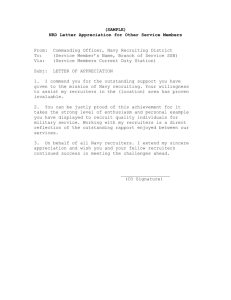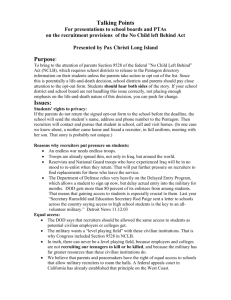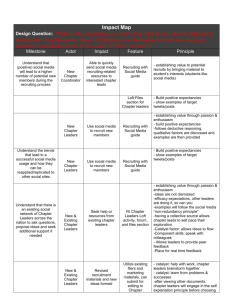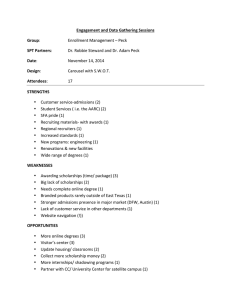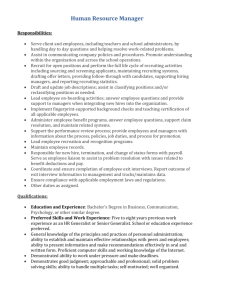GAO MILITARY PERSONNEL First-Term Recruiting
advertisement
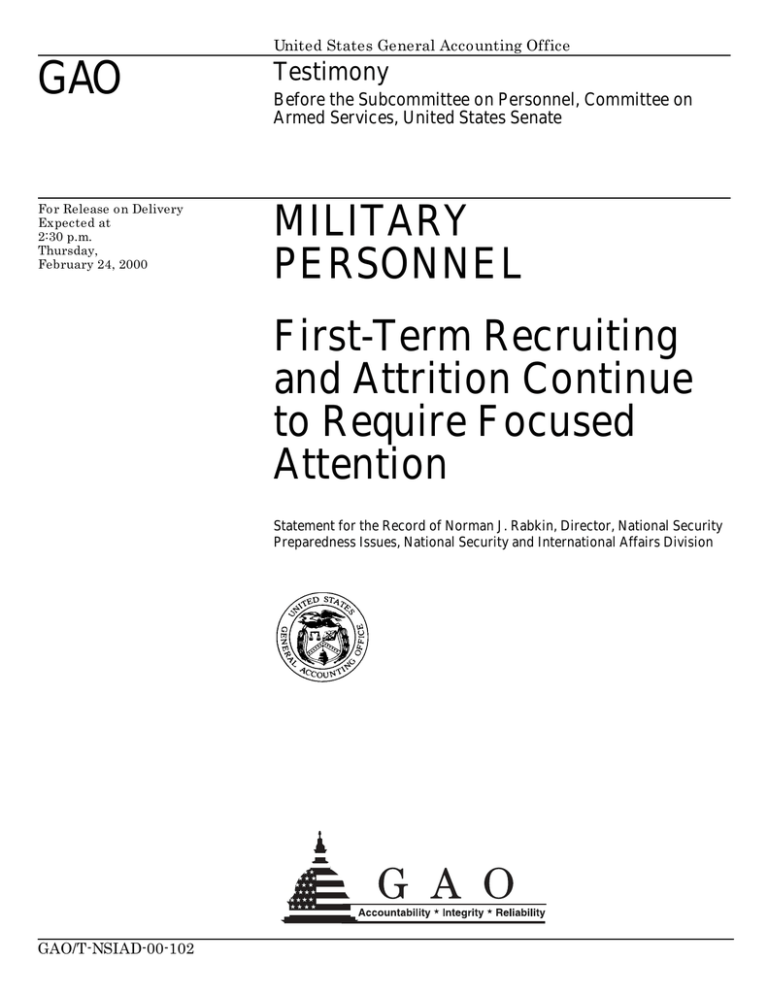
United States General Accounting Office GAO Testimony For Release on Delivery Expected at 2:30 p.m. Thursday, February 24, 2000 MILITARY PERSONNEL Before the Subcommittee on Personnel, Committee on Armed Services, United States Senate First-Term Recruiting and Attrition Continue to Require Focused Attention Statement for the Record of Norman J. Rabkin, Director, National Security Preparedness Issues, National Security and International Affairs Division GAO/T-NSIAD-00-102 Mr. Chairman and Members of the Subcommittee: I am pleased to provide this statement for the record on our ongoing work for this Subcommittee dealing with recruiting and attrition issues. The statement includes preliminary observations on ways the Department of Defense (DOD) and the services are attempting to meet their recent enlistment shortfalls and to reduce the attrition rate of their first-term enlisted personnel. These observations are based on ongoing work, including field visits to the services’ recruiting commands and basic training sites. We plan to summarize the results of this work in a report to this Subcommittee to be issued this summer. That report will contain a more detailed description of DOD’s actions, our conclusions about the success of various initiatives, and any appropriate recommendations. RESULTS IN BRIEF Over the past 2 years, the Army, the Navy, and the Air Force have been experiencing problems in recruiting qualified enlisted personnel. In response, these three services have all refocused their attention on this area and added resources to address perceived problems. For example, most have increased the number of recruiters and their advertising budgets, as well as offering larger enlistment bonuses and more money for college. All these tools have been shown by past research to help the services attract new recruits. The services have also sought innovative ways of expanding their shrinking recruiting market without reducing the quality of recruits. For example, the Army is 1 experimenting with attracting youth who do not have high school diplomas through its General Educational Development Plus Enlistment program, which will enable applicants who currently have not graduated from high school to be sponsored by the Army to attain enlistment standards through an attendance-based course. Also, all the services hope to more vigorously target students at community colleges. The Marine Corps has been successful in meeting recruiting goals; therefore, it does not plan to initiate any major changes to its recruiting program. The services’ problems with recruiting first-term enlistees are exacerbated by the fact that they have historically lost about one-third of their enlistees before they have completed their initial terms of service. Therefore, the services have also focused their attention on how to retain more personnel. While many of their initiatives appear promising, the latest 4-year attrition data available, for those who entered the services in fiscal year 1994 and left by the end of fiscal year 1998, indicate that this rate continued to rise and currently is at an all-time DOD high of 36.9 percent. As we point out in past reports, the services will not be able to develop appropriate steps to reduce attrition until they have more precise data on why these persons are leaving the military early.1 To obtain this type of information, DOD and the services are making progress collecting accurate data on why people leave the service early, especially for medical reasons. However, though the services have taken many initiatives to target enlistees whom they wish to rehabilitate, such as persons who fail the physical training test or appear to be struggling 1 Military Attrition: DOD Could Save Millions by Better Screening Enlisted Personnel (GAO/NSIAD-97-39, Jan. 6, 1997) and Military Attrition: Better Data, Coupled With Policy Changes, Could Help the Services Reduce Early Separations (GAO/NSIAD-98213, Sept. 15, 1998). 2 with academic or language problems in basic training, they have not yet extended their more extensive data collection effort toward these other types of separations in order to identify the root causes of the problems. BACKGROUND Fiscal year 1998 marked the first year in almost a decade that DOD did not meet its overall recruiting goal for enlistees. That year, the Marine Corps and the Air Force met their recruiting goals, but the Army achieved 99 percent and the Navy only 88 percent of their recruiting needs. In fiscal year 1999, the Marine Corps and the Navy met their goals, but the Air Force achieved only 95 percent of its goal, and the Army only 92 percent. For many reasons, it is difficult to compare the ways the individual services recruit and retain their enlisted personnel. First, with a goal of 74,500 for fiscal year 1999, the Army needed to enlist more than twice as many new recruits as the Marine Corps and the Air Force, and the Navy’s goal was a little over two-thirds of the Army’s. Second, coupled with the sheer size differences among the services, each offers a unique image or “brand name.” As a result, what works for one service may not work for another. Third, success in meeting recruiting goals has varied among the services. For example, until 1999, the Air Force had met its goal every year since 1979, and its recruiters have historically produced more recruits per recruiter. 3 For at least the past decade, the attrition of enlistees before the completion of their first terms has remained at around 30 percent. While the individual services’ attrition rates have varied during this period, all services’ attrition has remained within a broad band, ranging from around 25 percent to 40 percent. Generally, the Army’s attrition has been highest and the Air Force’s lowest. SERVICES ARE TAKING A VARIETY OF STEPS TO ADDRESS RECRUITING PROBLEMS Except for the Marine Corps, each service has either increased or plans to increase the number of recruiters, advertising budgets, and enlistment bonuses. In addition, the Army and the Navy are expanding their recruiting target markets. The Marine Corps has been successful in meeting recruiting goals; therefore, it does not plan to initiate any major changes to its recruiting program. Army Has Increased Recruiters, Bonuses, and Advertising The Army has missed its recruiting goals for the past 2 years. In response, the Army has been putting resources into areas that historically have proven to result in greater numbers of recruits, but it has not yet had time to fully analyze whether what has worked in the past is currently working or is likely to work in the future. For example, from fiscal year 1993 through 1998, the Army increased its number of recruiters from 4,368 to 6,331. It also increased its advertising budget from $32.8 million in fiscal year 1993 to 4 $97.2 million in fiscal year 1998. The Army has also offered an array of enlistment bonuses to qualified personnel and increased the maximum amount offered to $20,000. It has increased its budget for this purpose substantially in just the past year, from $58.2 million in fiscal year 1998 to $103.7 million in fiscal year 1999. The Army has also recently announced experimenting with new ways to expand its recruiting market to persons it would not have sought out in the past. For example, through its General Educational Development Plus program, the Army intends to target youth who do not have high school diplomas but who have higher-than-average aptitude scores and no histories of disciplinary problems. It also plans to focus attention on youth who are college-bound. The “College First” program, for example, proposes to pay enlistees attending college $150 per month for up to 2 years after they have signed a contract to enlist but before they actually do so. In an effort to more directly compete with private sector pay and benefits, the Army is developing what it calls a “Partnership for Youth Success Program.” Under this proposed program, the Army would obtain guarantees from private sector companies that the companies would have jobs waiting for specially trained enlisted personnel who successfully complete their tours. The companies would benefit by obtaining highly skilled personnel, and the former Army personnel would benefit by being assured a secure job, using their skills upon their departure from the Army. 5 Navy Met Its Recruiting Goal by Increasing Its Efforts The Navy missed its recruiting goal in fiscal year 1998 but met it in the following year. Navy Recruiting Command officials noted several factors that they believe enabled them to meet their recruiting goals in fiscal year 1999. For example, between fiscal year 1998 and 1999, the Navy increased its number of recruiters from 3,342 to 4,725. Simultaneously, it opened recruiting jobs to lower ranked, but "hard charging,” enlisted personnel. Also, between fiscal year 1997 and 1999, the Navy substantially increased its funding for advertising--from $41.1 million to $73.2 million. Finally, the Navy enhanced its bonus offerings to enlistees. For example, it awarded special bonuses of $3,000 to enlistees who agreed to enter basic training between February and May, a time when the Navy traditionally is hard-pressed to fill their slots. While increasing the amounts of resources spent on recruiting, the Navy also began to seek ways to expand its recruiting market. For example, it began to target personnel who have prior military service and persons without high school diplomas who scored high on newly defined selection criteria. The Navy is also targeting college-bound recruits under three separate programs. The first two are underway, and the third is being developed. Under the “Navy College Assistance Student Headstart” program, selected recruits in the nuclear and submarine fields are placed on active duty while they are in college, receive entry-level pay for up to 1 year, and then attend basic training. In the second program, called “Technical Preparation Partnerships,” the Navy coordinates with community colleges to allow recruits to earn their associates’ degrees while they are serving their first enlistment terms. A third program, the “Navy College Program,” which is under 6 development, will allow Navy servicemembers to receive college credit for Navyprovided training. Air Force Has Stepped Up Its Efforts After Falling Short on Its Fiscal Year 1999 Goal Air Force recruiting officials told us that complacency contributed to their inability to meet fiscal year 1999 recruiting goals. Air Force officials said that, because they had easily met their goals in the past, they generally believed that there would always be a readily available pool of recruits. Moreover, Air Force recruiters had historically signed up about two times more recruits than recruiters in other services while working fewer hours. For example, in fiscal year 1999, the Marine Corps employed 2,650 recruiters to recruit 33,685 new active-duty Marines, while the Air Force employed only 950 recruiters to recruit 32,068 enlistees. Banking on continued high productivity in fiscal year 1999, the Air Force did not staff its field recruiting force to its authorized level of 1,209. That is, even while the number of required annual enlistments increased and the Air Force said it became more difficult to recruit, the Air Force not only did not increase the number of its recruiters but allowed the number to fall below authorized levels. For fiscal year 2000, the Air Force plans to increase its authorization for recruiters by 237 to 1,446. Prior to this year, the Air Force also maintained a minimal advertising budget and had not requested money for paid advertising on commercial television. In fiscal year 1999, for the first time, the Air Force requested and received funding for television advertisements. The Air Force increased funding for all advertising from approximately $17.2 million in fiscal year 1998 to $76 million in fiscal year 1999. 7 In October 1998, the Air Force expanded its enlistment bonus program to target persons willing to commit to 6- rather than 4-year contracts in critical and highly technical skills, such as combat controllers, pararescue personnel, linguists, and security forces. The Air Force believed that offering such bonuses (1) positioned it for a better return on its recruiting and training investment, (2) provided another tool to attract youth into the Air Force, and (3) would result in improved retention over time and ultimately in a reduction in future requirements for new recruits without prior military service. Approximately 100 occupations are eligible for bonuses ranging from $2,000 to $12,000. Combat controllers and pararescue personnel are the only two occupations eligible for $12,000 6year enlistment bonuses and $3,000 4-year enlistment bonuses. Marine Corps Sees No Need to Change Its Recruiting Strategy The Marine Corps is the only service that has successfully met its recruiting goals each year. Consequently, it does not plan to initiate major changes in its recruiting strategy. Over the years, the Marine Corps has slowly but steadily increased its recruiting workforce and advertising budget. Recruiting officials believe they have been able to meet their goals because the Marine Corps has a consistent and recognizable identity to appeal to youth and an institutional, financial, and resource commitment to supporting recruiting services and because its recruiters work extremely hard. Data from the Defense Manpower Data Center’s 1998 survey of recruiters indicate that the Marine Corps’ recruiting success comes at a price. Marine Corps recruiters work longer hours and take less leave than recruiters in any other service. 8 The Marine Corps does not see itself in competition with the private sector to the same extent that the other services do. As such, it is institutionally against attempting to lure recruits with bonuses, changing its entry-level requirements, or increasing the number of recruiters. DATA AVAILABLE ON REASONS FOR ATTRITION REMAIN IMPRECISE As we have previously reported, the only available DOD-wide data on enlisted separations are not very useful in specifying why enlistees are leaving early. This is because the codes used to categorize separations are vague, more than one code can be chosen to classify the same separation, and the services use these codes differently. During our recent visit to the Military Entrance Processing Command, in Chicago, Illinois, we found that DOD and the services had in place long-term efforts to collect more precise information on the medical reasons enlistees were being separated early. Collecting such data will enable DOD and the services--at some point in the future--to make fact-based decisions on which medical conditions result in greater or lesser attrition risks. While DOD has formed a working group whose purpose is to revise all separations codes and to issue guidance to the services on how to more uniformly and consistently categorize all types of discharges, this effort was not progressing rapidly. At present, we see no evidence that the problems we previously identified with these codes have been solved. The current status of the codes does not allow DOD to make cross-service comparisons of attrition or to formulate fact-based policy changes to reduce it. 9 Early Separations for Medical, Physical, Background, and Performance Problems Notwithstanding the limitations of existing attrition data, it indicates that during the first 6 months of enlistment, there are three major categories of attrition: (1) separations for medical/physical problems, that is, for medical conditions that existed prior to service or for physical problems that develop while enlistees are in training; (2) separations for fraudulent or erroneous enlistment, indicating either that the services did not detect military applicants’ disqualifying conditions prior to their enlistments or that the applicants deliberately withheld disqualifying information from the services; and (3) separations for performance problems, such as failure of the physical training test, loss of motivation, or inability to adapt to military life. The remaining separations at the 6month point are for various reasons, none of which is particularly predominant. These reasons include misconduct, exceeding weight and body fat standards, character and behavior disorders, alcoholism, drug use, and homosexuality. (See fig. 1). 10 Figure 1: Primary Reasons That Enlistees Who Entered the Services in the First Half of Fiscal Year 1998 Were Separated in Their First 6 Months of Service All other problems Medical and physical problems 20% 31% 23% 26% Performance problems Fraudulent/erroneous enlistment To address these problems, DOD and the services have designed programs to address them where they occur, namely during the screening process and during training. Steps to Improve the Medical Screening of Enlistees To improve the medical screening of enlistees during their physical examinations at the Military Entrance Processing Stations, DOD has adopted our prior recommendations to 11 revise the medical form used to gather historical medical information on applicants for military service. It has also, in response to our recommendation, required military applicants to list their medical providers and insurers in hopes that applicants will more readily report their past medical histories if they believe that the services may try to verify information they provide. Ultimately, the Military Entrance Processing Command hopes to add medical screening tests, such as tests for asthma, at its processing stations that will help to screen out medical conditions known to be high attrition risks. Steps to Reduce Fraudulent and Erroneous Enlistments Recruits can be separated for fraudulent enlistment if they knowingly conceal information that would disqualify them from military service. Such a discharge can result from concealing the number of one’s dependents; from lying about prior drug use; or from failing to report a prior medical or criminal disqualifying condition. Recruits can be separated for erroneous enlistment if their disqualifying conditions are discovered after they enter the military, though this type of separation has also been used to discharge Navy enlistees who test positive on their drug tests upon arrival at basic training. To reduce the numbers of fraudulent and erroneous enlistments due to concealment of medical and psychiatric histories, the services have attempted to improve the gathering of prior medical histories of military applicants. To reduce the number of these enlistments due to concealment of criminal backgrounds, DOD and the services have also taken some 12 actions. For example, the Military Entrance Processing Command is now procuring funding for fingerprint machines from the services for their processing stations that will allow the services to do more thorough background searches of military applicants before they enter the service. Programs to Reduce Medical Injuries and Performance Problems Available data indicates that about 31 percent of all early separations are for performance problems, such as failure of the physical training test, loss of motivation, or inability to adapt to military life. Of this percentage, some of these separations occur because of physical injuries. Officials in the four training bases we visited believe that attrition because of performance problems can be reduced and have instituted programs to do so. The Army has targeted different groups of enlistees for retention at its basic training site at Ft. Jackson, South Carolina. Remedial training programs include a “Think It Over” program, targeting recruits who have second thoughts about basic training in the first week after they have arrived; a 4-day English as a Second Language program designed to help recruits who are struggling with their language skills; a Fitness Training Company for all recruits who fail the mandatory physical fitness test on the second day of basic training; 13 a remedial “Prepare to Train” program for recruits whose scores on the DOD entrance aptitude test suggest they might have difficulty in the academic portion of training; a “See It Through” program, targeted at recruits who have performance and behavioral problems during their first through final weeks of basic training; a mandatory Physical Training and Rehabilitation Program for all enlistees who are injured in training; and a 3-week remedial physical training course for enlistees who fail the Army Physical Fitness Test required for graduation from basic training. Fort Jackson officials estimate that in fiscal year 1999, they placed 7,612 enlistees in these programs, and 68 percent successfully completed their programs and were returned to regular basic training units. Prior to 1999, many of these persons might have been summarily separated. Fort Jackson is also attempting to reduce attrition resulting from unnecessary physical injuries. Training officials determined that providing athletic shoes designed to properly fit each recruit would reduce the threat of injury. While officials believe that it is logical to assume that such a change has resulted in reductions in injuries, they have not collected independent data to verify this assumption. The Navy has also attempted to retain more personnel in view of basic training attrition rates that grew steadily during fiscal years 1996-99—from 13.2 to 18.3 percent. Navy 14 officials believe that attrition rates would have gone even higher if they did not have the following six remedial programs: Fundamental Applied Skills Training, a 3- or 4-week course on academic skills; Personal Applied Skills Streaming, a 1-week program for recruits with anger, motivational, or other behavioral problems; the Academic Capacity Enhancement Program, a 5-day course to enhance recruits’ academic skills; a Battle Stations Remedial Unit aimed at recruits who have difficulty completing the final culminating field event; “PT-O,” a remedial physical training program designed to help recruits pass their initial physical training tests; and a Physical Fitness Training Unit to help recruits pass the physical fitness test required for graduation. Navy officials did not have data on the long-term success rates of these programs. However, in November 1999, their data showed that in fiscal year 1999, 861 enlistees were enrolled in the Personal Applied Skills Streaming program, 1,526 were enrolled in the Fundamental Applied Skills Training Program, and 1,555 were enrolled in PT-O. Before these programs were implemented, these persons might have been separated for performance problems. 15 Navy basic training officials have also taken several actions to reduce injury-related separations by redesigning their training program. This redesign has included rewriting the physical conditioning schedule, including how often recruits are required to run and march, and retraining drill instructors to emphasize the importance of keeping to a regimented routine to reduce stress fractures and other injuries. Data maintained by the Navy indicate that these efforts resulted in a reduction in the number of severe stress fractures between fiscal year 1998 and 1999. The Marine Corps has had some success in reducing attrition. Data provided by the basic training site at Parris Island, South Carolina, indicate that the Marine Corps’ attrition dropped from 17.8 percent in fiscal year 1998 to around 12.1 percent by fiscal year 1999, which is closer to the norm. Training officials attributed this drop almost entirely to a change in training philosophy that primarily involves spending more time with troubled recruits to bring them up to Marine Corps standards. Previously, enlistees might have been separated because drill instructors did not take the time to work with struggling recruits. Training officials stressed that such a change does not reduce quality or graduation requirements; it simply means that drill instructors are taking more time to train recruits and to target some enlistees who might previously have been separated. Retention is seen as a measure of leadership for both officers and enlisted drill instructors. In addition to this change in philosophy, training officials instituted new or reinforced ongoing programs to reduce attrition. Some of these programs were introduced well 16 before fiscal year 1999 and include a week-long remedial program to help recruits pass their marksmanship qualification and a physical conditioning program for enlistees who fail their initial physical fitness test. Marine Corps training officials said that 81 percent of all male recruits and 90 percent of all female recruits who were sent to the physical conditioning program were returned to training. Officials did not have information on how well Parris Island’s remedial programs were working in the long term. To reduce training-related injuries, Parris Island’s training officials introduced initiatives such as a Sports Medicine and Rehabilitation Therapy Clinic to rehabilitate rather than separate recruits who suffer injuries and to expedite their return to training. Marine Corps training officials noted that attrition due to lower extremity problems fell by 10 percent during the first 6 months after the Sports Medicine Clinic was opened. Air Force basic training officials said that they were satisfied with their level of attrition. When the rate rises above 11 percent, they become concerned. For fiscal year 1999, Air Force basic training officials report a rate of 8.4 percent. The Air Force began to make changes to its basic training regimen after a spike in the number of injuries during training in 1995. In that year, training officials began to alternate enlistees’ wearing of boots and athletic shoes, and in 1997, they added a central physical therapy clinic closer to where trainees were located. In January 1999, a new sports medicine specialist began to emphasize the importance of rehabilitating rather than separating enlistees who suffered injuries. Because of this change in philosophy, as well as the Air Force’s other 17 initiatives, the number of separations for medical reasons, including injuries, was reduced by half by the end of fiscal year 1999. - - - - This concludes our statement for the record. As noted, we plan to issue a more detailed report in the summer of 2000. Contact and Acknowledgments If you have any questions about this statement for the record, please contact Norman J. Rabkin at (202) 512-3610. Individuals making key contributions to this statement include Carol Schuster, William Beusse, Beverly Schladt, Joan Slowitsky, and Donna Rogers. (702052) 18 ORDERS BY INTERNET For information on how to access GAO reports on the INTERNET, send an e-mail message with “info” in the body to Info@www.gao.gov or visit GAO’s World Wide Web Home Page at http://www.gao.gov TO REPORT FRAUD, WASTE, AND ABUSE IN FEDERAL PROGRAMS Contact one: • website: http://www.gao.gov/fraudnet/fraudnet.htm • e-mail: fraudnet@gao.gov • 1-800-424-5454 (automated answering system)
